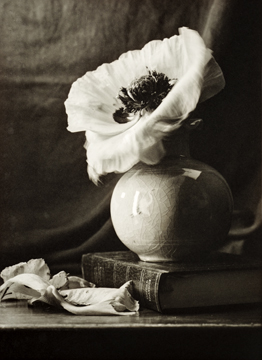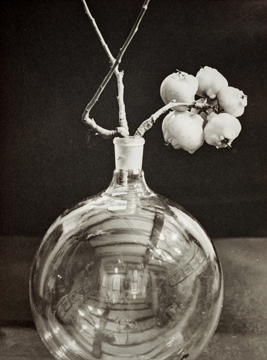The Wonder Of Chemistry: Apples & Flask – Platinum Palladium
Poppy And Old Books – Platinum Palladium
Platinotype: Platinum/ Palladium
Platinotype photographs are distinguished by a matte surface and subtle tonal gradations, the image is embedded in the fibre of the paper. Because of the tonal range and surface quality of platinum prints, many fine art photographers of the late 19th and early 20th century preferred the process over gelatin silver prints. The platinum printing process was developed in the 1870s, and commercially made platinum papers were available until the rising costs of platinum during World War I made the process prohibitively expensive. Platinum prints were replaced by the similar, but less-expensive, palladium prints. Today platinum and palladium prints are widely considered the princes of the photographic medium, and the greatest expressions of fine art photography. Printing in platinum and palladium is acknowledged as the summit of early print processes. Photographs are formed in a permanent ‘noble’ metal, graduated in tones of neutral grey or warm sepia offering luminosity in the high values. Platinum and palladium are used individually, or mixed in any proportion, controlling the image hue and contrast. https://www.mikeware.co.uk/mikeware/Platino-Palladiotype.html
About Robert Poole: (UK) I make photographs and original prints. To me, the photograph is defined as a photographic image, whether it is on film, paper, or a digital file. It can be shared online and still be a photograph; the same can’t be said, however, for a print. A print is a different entity entirely. I can lift it up or hang it on a wall, let it reflect or absorb light, direct or glancing, dull or bright. I can purchase one or gift one. They are tactile, tangible; the paper possesses colour and texture, like our skin: it lives. https://www.robertpoolecamerawork.com/


